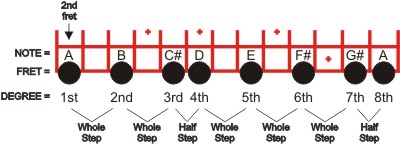« An object in motion? |
Main
 July 9, 2015 | Best of JM: Tetrachordal Approach to Major Scale Modes July 9, 2015 | Best of JM: Tetrachordal Approach to Major Scale Modes
Enjoy the popular archive material below.
From July 3, 2008 | Tetrachordal Approach to Major Scale Modes
Special thanks to Mark Wilson for this week's Tip:
A TETRACHORDAL APPROACH TO THE MODES OF THE MAJOR SCALE
© 2008 Mark Loren Wilson
Using a tetrachordal approach to learning and using the modes of the major scale is amazing. Thinking in tetrachords has a host of advantages and benefits:
- Solo sound. Reduces the complexity of learning scales and modes
- Speeds up the whole process of learning the fingerboard in every key
- Aids in having musical places to go in any direction from any starting note
- Lets the scales and modes simply fall from your fingertips
- Enables the proverbial "long line" when soloing
- Makes your lines more jazz-like by helping you get away from licks and employing a more scalar
WHAT ARE THE DEGREES OF A SCALE?
Notes of the scale are often called degrees of the scale. The first note in a scale is termed the first degree of the scale; the second note is termed the second degree of the scale, and so on. Major and minor scales have seven degrees.
WHAT IS AN INTERVAL?
In musical theory, the term interval describes the difference in pitch between two notes. The difference between any note and its next adjacent note (two adjacent frets on the mandolin) is the interval of a half step. The difference between any one note and the note two half steps away is called a whole step. For now, that is all we need to know, but you will find a chart of all the intervals on the accompanying PDF file.
HOW IS THE MAJOR SCALE CONSTRUCTED?
The major scale is constructed using a series of whole steps and half steps. Let's examine the A Major Scale.

The above example shows the A Major scale as played all on the G-string. You can see that the melodic intervallic structure of the major scale is a series of whole steps and half steps: W-W-H-W-W-W-H.
WHAT IS A MODE OF THE MAJOR SCALE?
The major scale has seven modes, one mode starting on each of the seven degrees of the scale. For example, the first mode of the major scale starts on the first degree of the scale. In A Major, the first mode would be to play A Major from A to A (A-B-C#-D-E-F#-G#-A). The second mode of the A Major scale starts on the second degree of the scale, and consists of the notes of A Major from B to B (B-C#-D-E-F#-G#-A-B). The third mode of A Major starts on the third degree of the scale and consists of the notes of A Major from C# to C# (C#-D-E-F#-G#-A-B-C#). The fourth, fifth sixth and seventh modes are, well, you have already figured it out.
WHY USE MODES?
Thinking in modes is handy for several reasons.
Reason #1: For me, it's a lot faster. Let's take the example of playing the II-V progression Bm7 to E7. You know it's a m7 chord resolving to a 7 chord, but what scale do you play for soloing?
1.Using Modes: Play 2nd mode, then 5th mode.
2.Without Using Modes: Figure out the parent scale these two chords are in, and then play that scale. For instance, Bm7 functions as a "2" chord in A Major, and the E7 functions as the "5" chord in A Major. In this way you have figured out the parent scale of these two chords is A Major. So, you play out of the A Major scale for soloing over this II-V progression.
Reason #2: I get to use the tetrachordal approach, and that makes it EVEN MUCH easier to select notes for solos.
WHAT IS A TETRACHORD?
A "tetrachord" is a four-note scale fragment. Any major or minor scale easily divides into two tetrachords. The first tetrachord consists of the first four notes of the scale, and the second tetrachord consists of the second four notes of the scale. For instance, the first tetrachord of the A Major scale is A-B-C#-D, and the second tetrachord of the A Major scale is E-F#-G#-A.
Posted by Ted at July 9, 2015 5:50 AM

Disclaimer: In the 'Information Age' of the 21st Century,
any fool with a computer, a modem, and an idea can
become a self-professed 'expert." This site does not
come equipped with 'discernment.'
|



